Source: Philips Lumec Blog
 |
|
(All photos courtesy of Philips) |
Chere Griffin, Copywriter for Philips Lighting NA conducted the following interview.
Helen Diemer – Shining a Light on Exceptional Service
Helen Diemer, President of The Lighting Practice in Philadelphia, PA, started her career as an electrical engineer, but was quickly drawn to lighting design. After graduating from Penn State University as an architectural engineer, she joined the Illuminating Engineering Society (IES) and International Association of Lighting Designers(IALD) and blazed her career path in lighting design. She joined The Lighting Practice in 1994; five years after Al Borden founded the firm.
Throughout her career, she helped to shape the lighting industry, having chaired the IALD’s Energy Committee, and serving on the IESNA Energy Management Committee. When energy codes were a major national focus, she helped to develop the lighting portion of ASHRAE/IESNA Standard 90.1. She was President of the IALD, and remains active in these organizations, as well as the ICSC, AIA, ASHE and others. Additionally, Helen contributes to industry publications and standards, and has also received numerous professional awards for her lighting designs.
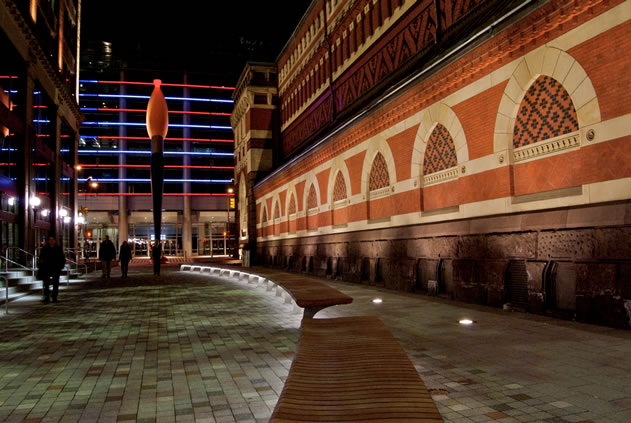 |
|
Lenfest Plaza, Philadelphia PA |
Your firm, The Lighting Practice, has been in business for 25 years. What are some of the most important factors contributing to your firm’s success?
Providing exceptional service and creative designs with a positive attitude are the trademarks that have led to our success. It starts with our team. We have motivated and service-oriented people with diverse backgrounds and a passion for lighting. They have a lot of personality and strength individually, and yet they form a strong team with a common goal of building something special and impactful for our clients. We have a really strong client service focus – we always work to exceed our clients’ expectations. Great projects come out of that, but it starts with understanding our clients – their goals, constraints and wishes – and taking care of them from start to finish.
How do you use lighting to convey a message or emphasize a brand?
Lighting always sends a message, so, you want to be very conscious to craft and convey the right message. For our projects, we try to develop a storyline, metaphor, or visual image that guides the lighting design. This may be based on something in the architectural design, or something about the client’s goals or the image they want to project. Several years ago, we were tasked to light the exterior of one of the oldest U.S. prisons, the Eastern State Penitentiary in Philadelphia. It’s not active anymore; it’s a historic landmark site, where they run tours – including a popular Halloween tour. It’s an ominous gothic structure, so rather than taking an architectural approach, we wanted to use the lighting to recreate the anxiety and fear that prisoners felt when they first approached the building. Our idea was to model the lighting after film images of Dracula’s castle to make it look intimidating and imposing. When we shared this concept and images with the client, they were convinced. We used light in unexpected ways, with a lot of contrast, like grazing light at angles across the building facades, and lighting spaces between crenellations. It has this eerie effect that is very successful, and all based on that storyline.
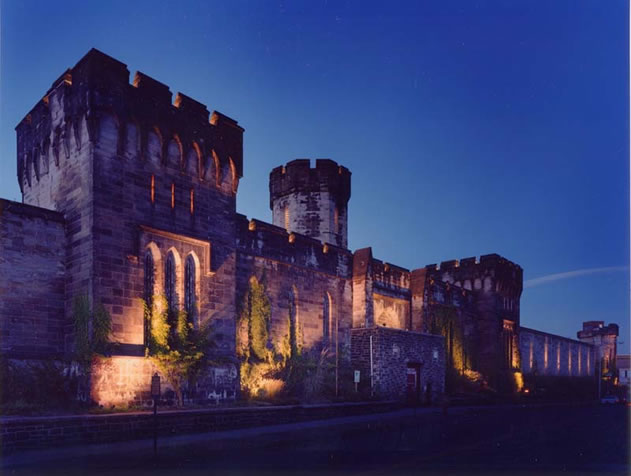 |
|
Eastern State Penitentiary, Philadelphia |
On the other end of the spectrum, one of our current projects is Dayton Children’s Hospital. Here, we’re creating an environment that will provide positive distraction for young patients and their families. Our concepts are based on children’s story book imagery – where an atrium bridge becomes a flying carpet and strands of sparkling pendants are pixie dust. Developing the story line helps to guide our design, and allows our clients to visualize the design intent and confirm the image they want to portray.
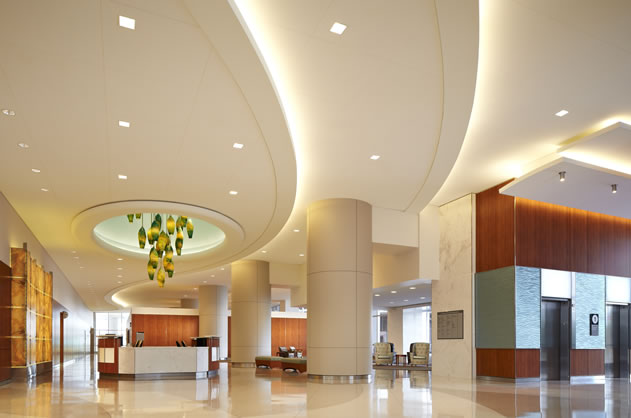 |
|
Texas Children’s Hospital, Houston |
How important is sustainability to your clients? How do you balance sustainability with function and aesthetics?
Sustainable lighting design starts with using lighting only when and where it’s needed to create the desired effect. I tell clients, “Lighting is not like peanut butter – you don’t have to spread it to the edges of the bread.” Use it effectively where you need it to make a compelling statement. This is the first step towards managing lighting costs and energy usage. Once you have the lighting strategy, then you select lighting equipment and controls, and that’s where the technology piece comes in. Putting the technology before the overall strategy is like putting the cart before the horse.
We look for the most efficient and long life sources that are practical for the job. We try to use lamp and fixture types that will work in multiple spaces, to make it easier and more affordable for our clients to operate and maintain. With LEDs, we spend a lot of time researching products that have modular, replaceable components so we’re not creating a “throw-away” system that must be completely replaced when a single component fails. Minimizing waste is another component of our sustainable lighting strategy.
What can lighting manufacturers offer or develop to make your lighting projects easier/better?
I’d like to see more standardization and more concise and reliable product data. As a lighting designer, I find it frustrating that everybody seems to offer their own flavor of LED. So whereas I might have been able to find a half dozen downlights with a 32W CFL that I could rely on to do similar things, I now have a half dozen or more LED products, and every one of them has unique characteristics – different beam spreads, light outputs, light delivery methods, available color temperatures. This makes it difficult to write a coherent, competitive specification. We would benefit from standardization and simplification as opposed to endless variations in basic products.
Manufacturers can also provide easier access to information like lumen output and light distribution. The product data sheets often don’t include this information which we need for our specifications. Instead we have to find this on a separate IES photometric report. It would be simple and straightforward to have it on one product data sheet that does not require wading through several pdfs or links on a manufacturer’s website.
What is your most memorable project and why?
One of my most memorable projects was for Johnson & Johnson almost 20 years ago. It sticks with me because it was one of those perfect projects where lighting and architecture were beautifully, elegantly integrated. The project was a renovation of a large, single-level diaper factory for use as a corporate office. So, imagine this big, flat, fairly anonymous-looking box, and the architect needed to convert this into state-of-the-art offices and labs, with a welcoming entry for visitors and circulation paths and spaces for executives and scientists to gather and collaborate. The architectural solutions were very creative and included inserting a two story glass box “lantern” for the main entry and a tremendous canoe shaped atrium with full skylight as the central gathering space and nexus for circulation through the building. What I loved about working on this project was that we collaborated closely with the architect, starting early on, to find ways to integrate lighting in very discrete ways. We talked about how lighting could help to create the entry lantern effect, guide circulation and reinforce gathering spaces – and then we worked together to subtly tweak and adjust the architecture so that lighting was inserted seamlessly to create the desired effects. So the end result is a place where the light just feels like it is part of the architecture.
From a technology standpoint, we used simple tricks of mixing sources like fluorescent and metal halide with slightly different white light color temperatures, and we were able to place those sources to emphasize the layers and reveal the architecture’s depth. It was a simple solution where lighting doesn’t stand out and say “Wow”, but the overall effect was just beautiful.
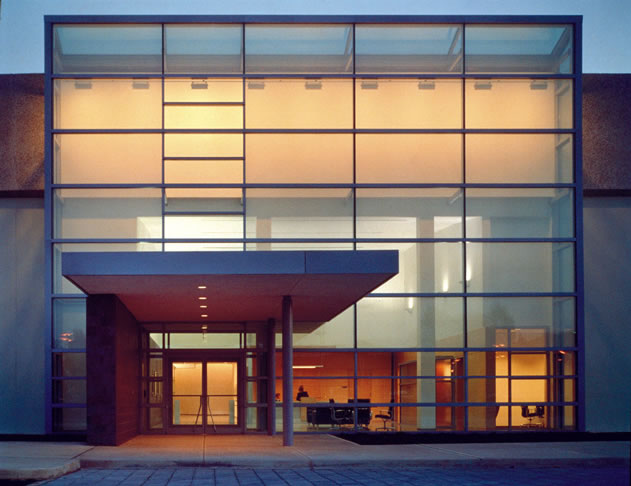 |
|
Johnson and Johnson building |
What trends do you see shaping your design business in the next 3-5 years?
Compressed project schedules, using BIM/Revit for project documentation and more complicated lighting systems. We live in an instant gratification/high expectation society where people want high quality projects delivered more quickly, with fewer errors and for less money. This requires increased collaboration among all team members – from ownership, design and construction to material suppliers. I believe this will also lead to a bigger, more important role for lighting designers.
LED’s increasing viability and dominance are the biggest things changing our business. Lighting designers need to be more tech-savvy than ever before; they need to have a much better grounding in how these electronic lighting devices work with lighting controls. Providing lighting control design, not just lighting control intent, is becoming a required service for lighting designers, not something that can be passed off to the electrical engineer.
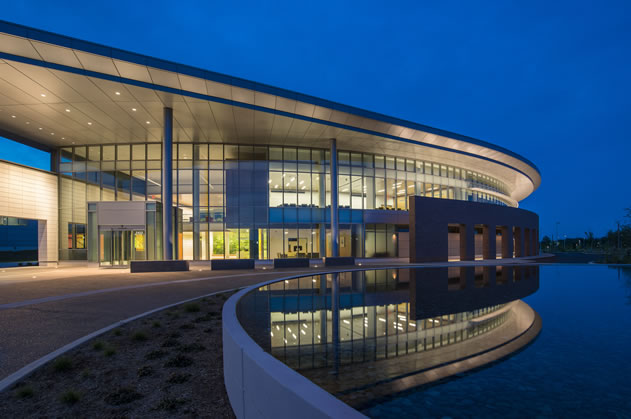 |
|
LGH Cancer Institute, Pennsylvania |
This also means that we need excellent technical service and field support from our manufacturing partners. Our experience in using LED so far is that the systems last a long time once they’re up and running, but the initial installation can be hair-raising. We need all of our partners to support and help us so we all have happy clients in the end.





 CN
TW
EN
CN
TW
EN











